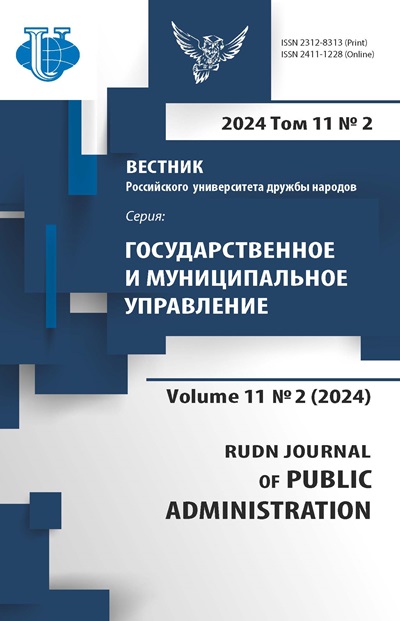Планирование рабочей силы и эффективность организации: взгляд государственного служащего штата Осун
- Авторы: Олонаде З.О.1, Омотойе О.О.2, Олалеми О.П.3
-
Учреждения:
- Осунский государственный университет
- Университет Тиссайд
- Университет Лид-Сити
- Выпуск: Том 10, № 2 (2023)
- Страницы: 286-298
- Раздел: МЕЖДУНАРОДНЫЙ ОПЫТ ГОСУДАРСТВЕННОГО УПРАВЛЕНИЯ
- URL: https://journals.rudn.ru/public-administration/article/view/35884
- DOI: https://doi.org/10.22363/2312-8313-2023-10-2-286-298
- EDN: https://elibrary.ru/UKKLGO
Цитировать
Полный текст
Аннотация
В статье изучается влияние планирования рабочей силы на организационную эффективность государственной гражданской службы на примере штата Осун в Нигерии. Используемый дизайн исследования представляет собой описательный опрос, в то время как приблизительная численность сотрудников министерств составляет 11 243 человека. В этой статье для сбора данных используется двухэтапный метод выборки. В общей сложности для исследования были использованы 240 полностью заполненных анкет. Гипотеза была проверена с помощью методов корреляции и регрессионного анализа (линейный коэффициент корреляции). Результаты показывают очень значимую линейную корреляцию между кадровым планированием и организационной эффективностью на уровне значимости 0,05. Кроме того, кадровое планирование значительно влияет на организационную эффективность государственной гражданской службы штата Осун. Сделан вывод о том, что кадровое планирование повышает эффективность организации. На основании вывода приводится рекомендация для отдела кадров разработать и внедрить комплексную программу обучения развитию карьеры.
Ключевые слова
Об авторах
Закчеус О. Олонаде
Осунский государственный университет
Email: zaccheaus.olonade@uniosun.edu.ng
ORCID iD: 0000-0002-8815-5677
доктор философии, департамент развития человеческих ресурсов
Нигерия, Осогбо ул. Оке Бале, Зона 210001Олуватоби О. Омотойе
Университет Тиссайд
Автор, ответственный за переписку.
Email: omotoyetobio95@gmail.com
ORCID iD: 0000-0001-6556-8690
Международная школа бизнеса
Великобритания, Мидлсбро, ул. Саусфилд, Кампус Харт, TS1 3BXОлуватоин П. Олалеми
Университет Лид-Сити
Email: olalemitoyin@yahoo.com
доктор философии Нигерия, Ойо, Ибадан, пр. Оба Отудеко, 200255
Список литературы
- Study Pack on Advance Employment Relations Professional II. Chartered Institute of Personnel Management of Nigeria; 2013. 217 p.
- Mathis R.L., Jackson J.H. Human Resource Management, 12th Edition. USA: Thomson South-Western; 2008. 832 p.
- Bulla D.N., Scott P.M. Manpower Requirement Forecasting. Human Resources Planning Society. New York: Plenum Press; 1994: 145-155.
- Barnard P.R. Researches the Complete Stress-strain Curve for Concrete. Magazine of Concrete Research. 1964; 16 (49): 203-210.
- Drucker P.F. Effective Decisions. Harvard University: Graduate School of Business Administration; 1967. 7 p.
- Mangwengwende T., Chinzara Z., Nel H. Bank Concentration and the Interest Rate Passthrough in Sub-Saharan African Countries. Economic Research Southern Africa. 2011;233:30 p.
- Opoku-Mensah Y. An Analysis of Human Resource Planning and Its Effect on Organizational Effectiveness - a Case Study of Information Services Department, Accra Office. Doctoral dissertation. 2012. 92 p.
- Schein E.H. Increasing Organizational Effectiveness through Better Human Resource Planning and Development. Sloan Management Review. 1976; 19 (1): 1-20.
- Tende F., Alagah A.D. Influence of Human Resource Planning on Organizational Performance of Fast Food Companies in Port Harcourt, Nigeria. Imperial Journal of Interdisciplinary Research (IJIR). 2017; 3 (11): 458-467.
- Appah E., Oyandonghan J.K. The Challenges of Tax Mobilization and Management in the Nigerian Economy. Journal of Business Administration and Management. 2011; 6 (2): 128-136.
- Abasimfon P.E., Ibieran J. Ugochukwu D.A. Manpower Planning and Organizational Effectiveness; Evidence from a Nigerian Public Bureau. Lead City Journal of the Social Science (LCJSS). 2020; 5 (1): 38-45.
- Odumeru J.A., Ilesanmi O.A. The Effects of Human Resources Development on Financial Performance of Organizations. Asian Business Review. 2013: 2 (1): 19-23.
- Edeh F.O., Dialoke I. Effect of Human Resource Planning on Organizational Performance of the Hospitality Sector in Nigeria. Business Perspective Review. 2020; 2 (1): 1-12.
- Pamela A.C.J., Umoh G.I., Worlu G. Human Resource Planning and Organizational Performance in Oil and Gas Firms in Port Harcourt. Human Resource Planning. International Journal of Advanced Academic Research Social & Management Sciences. 2017; 3 (9): 111-129.
- Ifeanyichukwu D.M. Effects of Workforce Planning on Organizational Performance: A Study of Selected Media Houses in Imo State. International Journal of Social Sciences and Management Research. 2017; 3 (2): 1-11.
- Ashraf G., Kadir S.A Review on the Models of Organizational Effectiveness: A Look at Cameron’s Model in Higher Education. Journal of Education Studies. 2012; 5 (2): 80-87.
- Iyer B., Davenport T.H. Reverse Engineering Google’s Innovation Machine. Harvard Business Review. 2008; 86 (4): 58-68.
- Mishra P. Misra R.K. Information Technology and Quantitative Management (ITQM) Entrepreneurial Leadership and Organizational Effectiveness: A Comparative Study of Executives and Non-executives. Procedia Computer Science. 2017;122:71-78.
- Obi J.N. Effective Human Resources Management Practices as the Key to organizational performance. International Journal of Educational Research. 2015; 3 (1): 1-26.
- Ridley C.R., Mendoza D.W. Putting Organizational Effectiveness into Practice: The Preeminent Consultation Task. Journal of Counselling and Development. 1993;72:168-178.
- Barney J. Firm Resourcesand Sustained Competitive Advantage. Journalof Management. 1991; 17 (1): 99-120.
- Wernerfelt B. A Resource-based View of the Firm. Strategic Management Journal. 1984; 5 (2): 171-180.
- Moyo N.J. The Contribution of Human Resources Planning in Public Institution’s Performance: A Case Study of Mlele District Council. Doctoral dissertation. The Open University of Tanzania; 2015: 189 p.
- Afzal F., Mahmood K., Sherazi S.M.R., Sajid M., Hassan M. Effect of Human Resource Planning on Organizational Performance of Telecom Sector. Information and Knowledge Management. 2013;2:173-182.
- Kiai D., Lewa P., Karimi, J. Influence of Human Resource Planning on Performance of Firms Listed in the Nairobi Securities Exchange in Kenya. International Journal of Research in Business and Social Science (2147-4478). 2019; 8 (5): 54-61.
















